A 2020 paper issued by the National Fire Protection Association (NFPA) highlights the fire dangers associated with improperly maintained clothes dryers. Almost four percent of all structural house fires start with a clothes dryer fire. One third of those dryer fires are due to dryer lint which ignites causing a fire. In each of the four years reported in the NFPA paper, there were almost 14,000 fires, which caused seven deaths, 344 civilian injuries, and $233 million in direct property damage.
Lint is a collection of tiny fabric fibers created by friction on your clothes during the drying process. Some of the lint is caught by the dryer’s lint trap and some gets into the dryer’s exhaust system and dryer vent system. Lint is highly flammable.
Some newer dryers have a vent sensor to alert you when there is a lint build up. However, Consumer Reports research shows these don’t work well except when reporting completely blocked vents…well into a fire danger zone. Follow these simple rules to keep your dryer safe:
- Be sure that your dryer is installed correctly by a professional.
- Clean the lint trap after every single use and encourage your family to do likewise. For most dryers, just remove the lint trap from its easily accessible slot, scrape the fluff off the mesh, and slide the filter back in. This will also help to keep your dryer at peak performance.
- At least once a year clean the vent duct behind your dryer using a vacuum cleaner hose. If you can’t get behind your dryer easily, there are vent cleaning accessories that can help. If you have a plastic or foil accordion-style duct connecting your dryer to the outside vent, it’s a good idea to replace it. These are risky because they can sag, allowing lint to build up at low points and trapping lint in their ridges. Rigid metal ducts using duct connectors or clamps rather than screws, afford smooth walls for air to flow, and reduce the buildup of lint.
- Vacuum up the lint around the back of the dryer, which can also be a potential fire hazard.
- Be careful what you put in your dryer. Dry items stained with volatile substances like gas, oils, or cleaning agents on a line after washing several times. If you must use the dryer, use a low heat setting and monitor carefully. Click for more Dryer Safey Tips
If a fire does start, keep the dryer door closed to limit its oxygen supply—a fire needs oxygen to keep it going.

